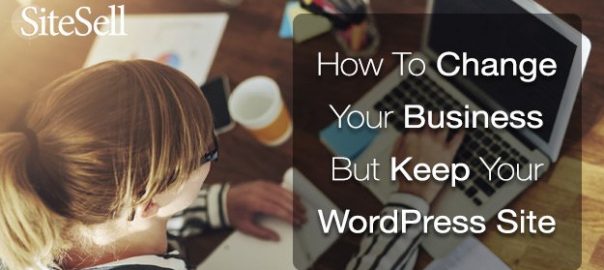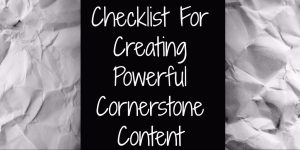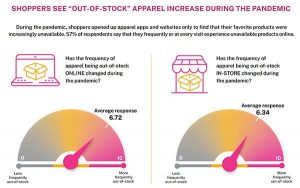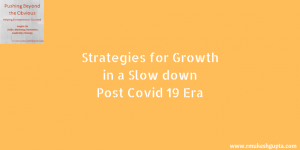
What happens to your website when you decide to change the direction your business is going?
Do you have to start all over from scratch?
If you’re making a huge change, say, from blogging about car racing to selling books and videos about holistic health remedies, you probably do. But if you’re only pivoting — changing direction and focus within the same subject area — your website can change right along with you. If you’re keeping the same domain name, there’s no reason to start a whole new website.
Your transition will go more smoothly if you plan carefully and strategically. For some of us, the planning is the hardest part of the process. I love to just dive in, but you’ll save yourself a lot of time and effort if you resist that particular temptation.
The process that will save you time and aggravation is similar to what I used to do every year around this time when my kids were young.
Before the new school year started, they were always anxious to get decked out in their spiffy new school clothes. Being the Meanest Mom on the Block, though, I wouldn’t take them shopping until they had done two things:
- Inventoried what they already had
- Listed what they needed
During the inventory process, we also threw out or gave away clothing that was too small, excessively worn, or wasn’t suitable in some other way. Only after this process was complete would we begin our shopping.
That’s basically the same process you’ll go through with your website before you start making changes.
Step 1: Assess What You’ve Got
Inventory Content Assets
Create an inventory of your site’s current content. If your site is small, you can probably do this in a document or Evernote note, but if you have more than about 30 pieces of content, you’ll find a spreadsheet works better.
At a minimum, include columns for:
- Title
- Author (if there are multiple authors)
- Keyword
- Category
- Evergreen (Yes/No)
- Date of publication
- Audience (beginner, intermediate or advanced, for example, or men/women)
Evergreen above refers to whether the content is evergreen and foundational, or more time-sensitive or topical. For example, on my WordPress site, an articled titled, What is WordPress is an evergreen topic (sometimes called a pillar topic). I might update it occasionally, when WordPress releases major changes, but it’s essential to my niche and it doesn’t change much over time.
Other topics are more timely. The release of version 4.3.5, and a description of what’s included in that release, would be an example. Since the evergreen content provides the foundation for your site, it’s important to make the right changes in that content when you pivot your business.
Depending on your niche, create relevant additional columns, as needed. Then review each piece of content, and enter the information into your spreadsheet.
Inventory Other Website Assets
This includes all your plugins, any modifications you made to your current theme that you may want to duplicate in your new theme, and all your widgets.
List your plugins, then check your new theme to see if you can eliminate some of the plugins. If you’ve been using a plugin to create a mobile version of your site, but your new theme is mobile responsive, getting rid of that one is a no-brainer. If you’ve used a plugin to place a favicon, you can now handle that directly in WordPress. Check any plugins you’ve been using to display video or provide an audio player — WordPress now displays those files very well.
I like to take screenshots of sidebar and footer widgets as it’s the quickest way to make sure I’m placing them in the correct order.
Inventory Non-Website Assets
Although these might not all reside on your website, you should have a clear picture of your other business assets. These might include:
- Mailing list
- Social media accounts and audience
- Ebooks / Kindle books you sell
- Courses you teach
- Other items you sell
Once you pivot your business and change your WordPress theme, will you need to make changes to these assets?
Step 2: Determine What You’ll Need
Before you start on this phase, you should be very clear about your business goals and sales funnel.
Just like my kids used to make three piles — keep, give/throw away, or replace — you’ll do the same with existing assets.
- Keep as is — content and other assets you don’t need to change at all.
- Keep with modifications — content you’ll need to tweak to bring it in line with your new business goals.
- Throw away — some of your current assets may simply be unsuitable for the new direction you’re taking. By all means, make a backup and store all the outdated content, but if it doesn’t fit the new model, remove it. It may be painful now, but it will be less confusing for your readers and will clear your path for other necessary changes. Make sure you also have a plan in place to redirect traffic that may look for removed content — set up either a redirect to your site’s homepage, or to a similar piece of content that you’re keeping.
- Buy new — you may need to write some brand-new content that reflects your business pivot, or design new logos and other branding elements.
Once you’ve made your list and you know what you’ll be changing, you have a choice to make — change it now, before switching themes, or after. There are pros and cons to both approaches.
My preference would be to make necessary changes to #2 and #3 now — tweak the content that needs tweaking, and get rid of outdated content. That will leave less for you to handle while you roll out your new theme.
Step 3: Select a New WordPress Theme
Once you’re clear about your business plan going forward, and the content and other assets you’ll be keeping, it’s time to choose a new WordPress theme. (Here’s a recent post to get you started.)
Important questions to ask yourself before choosing a new theme include:
- What’s the site’s main purpose?
- What’s the primary type of content — text, video, audio, images?
- Will most of your readers come from the local area?
- What’s the most important action you want your readers to take when they land on the homepage? Does the theme you’re considering make that action easy?
- Does the theme make it easy to guide readers to take desired actions throughout the site?
If you’re a travel blogger and your site’s main purpose is to showcase your work so editors will hire you to write for them, and you plan to monetize by selling advertising, you need a theme that displays large images beautifully, along with attractively presented written content and an efficient way to display advertising. Having a map feature would be helpful as well.
If you’re selling a handbook about raising chickens in your back yard, you don’t need to emphasize the images so much.
If you sell the lightest, most complete line of backpacking equipment, you’ll want some sort of ecommerce functionality.
If the most desired action on the homepage is to sign up for an email list, does the theme make it easy to build that form and place it prominently? If the most desired action is to follow you on Facebook, what does the theme provide to facilitate it? Sure, you can always use plugins for these things, but it’s better if your theme offers it out of the box.
It’s worth mentioning here that if you’re looking at a theme that is not mobile responsive, look elsewhere. You don’t want to start out with a handicap — if your site isn’t responsive, Google penalizes you in mobile searches and you’re doing a disservice to the 30%-plus number of readers who will come to your site on a mobile device.
Switch to the New Theme
If you can, it’s a good idea to set up the new theme on a staging site so you can tweak it before it goes public without taking your site offline. You can set up a hosting site on your computer, or your web host may offer staging sites.
If this is not a realistic option for you, don’t despair. You can still get your site changed over with minimal downtime. Before you start, though, download and install two plugins: a maintenance mode plugin — there are lots to choose from — and Regenerate Thumbnails.
The maintenance mode plugin lets you hide the site from public view while showing a notice to let readers know it’s not available temporarily. Choose a plugin that lets you create your own message. It’s up to you whether you want to let your audience know there are big changes coming.
Different themes display differently sized thumbnail images. You may not need it, but if your new theme shows thumbnail images that are not uniformly sized, or if they’re blurry or look odd in some other way, Regenerate Thumbnails will clean up the images for you.
It’s a good idea to switch themes during a low-traffic day and time.
#1. Back it Up!
Use a backup plugin like Updraft Plus or WP-DB Manager to back up your entire WordPress site, database and file system. It’s also a good idea to use an FTP program like Filezilla to download all your site files onto your computer. Save them in a secure location.
#2. Check the Custom Menus
If you’ll use the exact same menus, you’ve nothing to do in this step. However, if you plan to change your menu structure, create the new menu(s) ahead of time. Don’t change your existing menus, but create new ones to use with the new theme. Doing so will cut down the length of time your site will be in maintenance mode.
#3. Install the New Theme
Go ahead and install your new theme — from your WordPress Dashboard, select Appearance / Themes, then Add New. Follow the prompts to add it or upload it from your computer.
#4. Activate Maintenance Mode
Before you activate your new theme, enable the maintenance mode plugin you installed previously. You’ll be able to see the site while you’re logged into the dashboard, but you do not want your readers to see the site when you first install the new theme!! (It’ll be ugly for the first few minutes.)
#5. Activate the New Theme
Activate the new theme, then review your site. At the very least, you will definitely need to:
- Apply custom menus.
- Restore sidebar and footer widgets
Go ahead and do that now.
You’ll also likely need to:
- Rebuild your front page, especially if you’re moving from a more traditional website to a scrolling homepage type of site
- Regenerate thumbnails, using the previously installed plugin.
You may also need to restore featured images. If your old theme was set up to use the first image as the featured image, make sure your new theme is configured the same way. If it does not offer that option, you’ll have to add those featured images back.
#6. Deactivate Maintenance Mode
Once you’re satisfied, you can deactivate the maintenance mode plugin. Now readers will be able to see your new site!
Don’t be surprised if you spot a few strange behaviors. In fact, I would recommend enlisting your readers’ help in debugging. Send out an email to your list announcing the new look and new direction for the website, and ask them to let you know if they spot anything strange while they’re browsing the site.
#7. Clean Up
Once you’re satisfied the site is looking and working the way you want it to, it’s time to go back in and do some cleaning.
- Deactivate and uninstall the plugins you no longer need.
- If you created new custom menus, delete the old ones.
- Check for shortcodes that are no longer needed! If you removed a plugin that created shortcodes, make sure they’re not showing up on pages where readers can see them.
- Remove old logos and other branding assets you’re not using any longer.
That’s it! Enjoy your renovated website.
Digital & Social Articles on Business 2 Community(38)
Report Post







